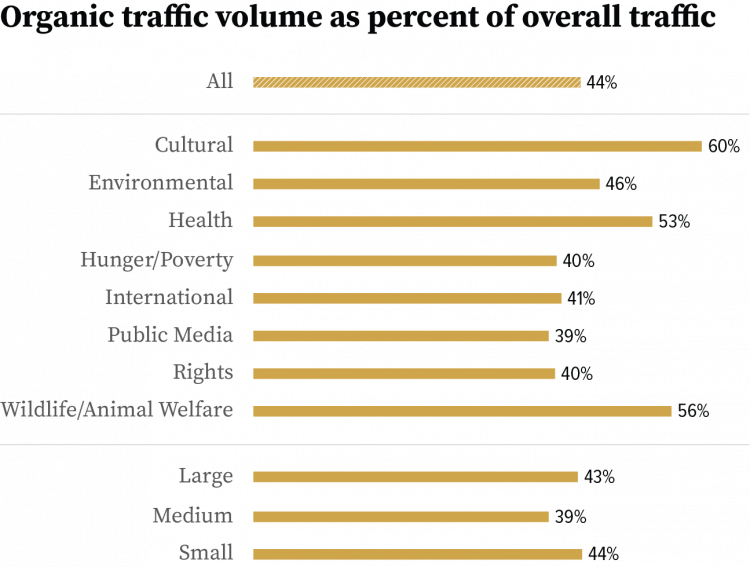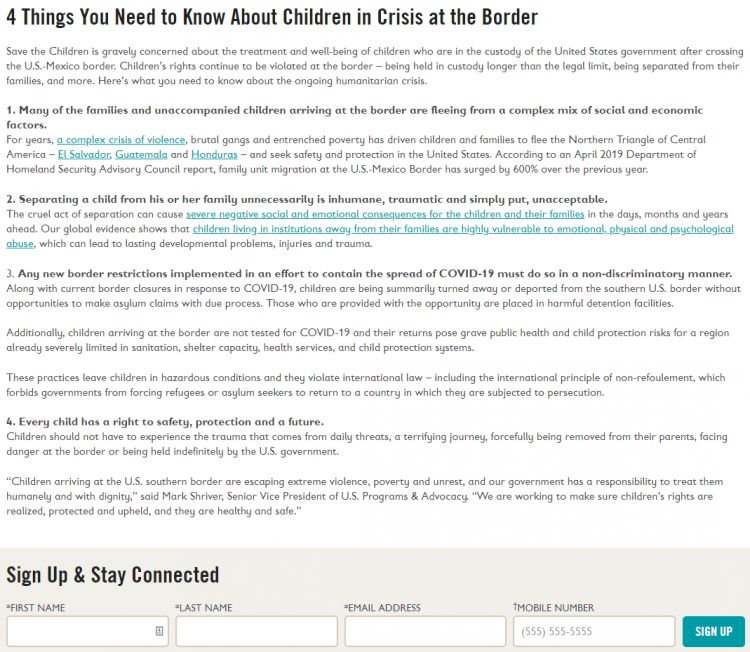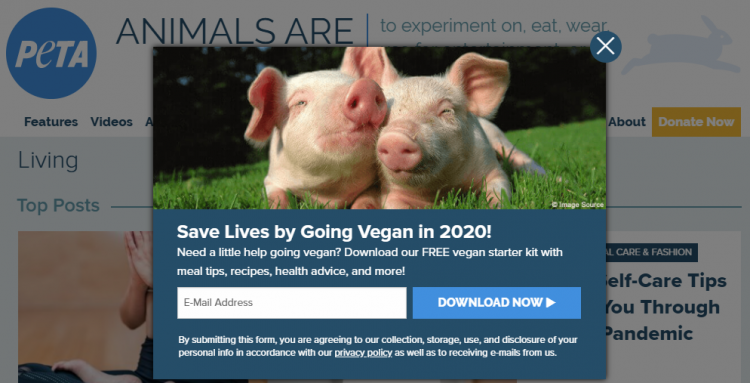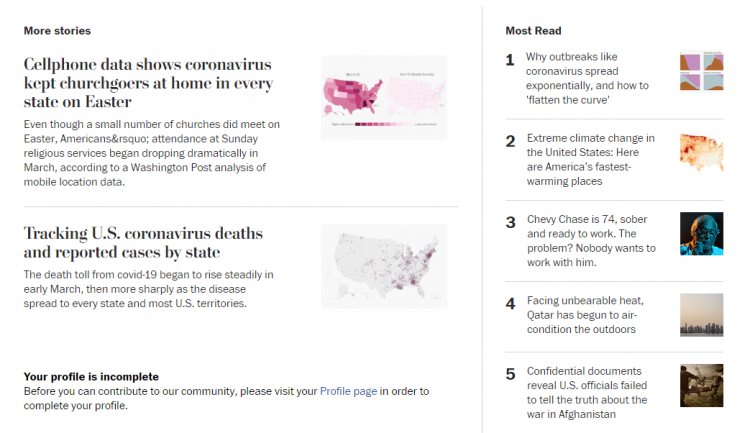Click here to read the post on Classy
3 Ways to Convert Organic Traffic Into Long-Term Support for Your Nonprofit
by Karen Hopper
This post was written by Karen Hopper, the Senior Data Strategist at M+R. When she’s not geeking out over Google Analytics, she enjoys singing, biking, and baking banana bread, like most other quarantined millennials.
According to the 2020 M+R Benchmarks Study, 44% of all website traffic for the average nonprofit comes from Organic Search. For groups that produce a lot of content, have a physical local location, or have hyper-focused SEO strategy, that proportion can be much higher.

These high numbers make sense, since nonprofits have a natural mix of relevancy and answers to some of the world’s biggest questions—everything from climate change and reliable health information to how to crate train your newly adopted pug. We also know that relevance by creating focused content is one of many excellent ways to improve search engine results page (SERP) performance.
However, this traffic isn’t doing much once they get to an organization’s website. The M+R Benchmarks Study also shows that only 0.17% of organic visitors make a donation in the same session, generating an average of $0.30 from each organic search clickthrough. Generally, as the proportion of traffic from organic search goes up, the proportion of visits that result in a donation (and revenue per visit) goes down. Ouch!
The prevailing assumption is that the users who click through to your website after querying a search engine with a specific question aren’t qualified to become long-term supporters because they’re focused on answering their question as quickly as possible before moving on. Nonprofits have fallen victim to this assumption time and time again; experience optimizing websites for dozens of organizations has shown us that nonprofits often go out of their way to make the visit to their content sections as sterile as possible, often removing calls to action and logos, trimming images to make the page load more quickly, and writing content without any reference to the nonprofit providing the information at no cost to the visitor.
Free Download: The Nonprofit’s Digital Marketing Checklist
While this approach may boost a page or two up in search rankings and increase traffic volume, it does very little to convert organic traffic and build a relationship with that visitor. Additionally, our report shows it doesn’t increase revenue either. There’s a balance to strike between hyper-focused content and building an audience of potential advocates and supporters. After all, isn’t that one of the reasons why we’re producing content for our websites, and why we want to out-rank our competitors? Taking a page out of the ecommerce marketing strategy book would serve us well here, especially as it relates to inbound marketing.
As defined by Hubspot, inbound marketing is a methodology that attracts customers by creating valuable content and experiences tailored to them. While outbound marketing interrupts your audience with content they don’t want, inbound marketing forms connections they’re looking for and solves problems they already have. Sounds an awful lot like the work we already do to produce content that is intended to rank well in organic search, doesn’t it?
So, following the principles of inbound marketing: we’re ranking in search, we’re getting the click-throughs, but how do you take the next step and apply the principles of relationship building towards sales to nonprofit content, since a “customer” in the ecommerce sense doesn’t translate to nonprofit particularly well? Below, we’ll provide three ways you can build relationships and convert organic traffic into long-term supporters.
1. Introduce Yourself and Your Values Within the Context of the Answer
Visitors resulting from organic search queries provide a unique opportunity to connect with, and educate, an audience who might not be familiar with your nonprofit since they’re often searching for answers related to a specific topic, not your organization by name. While your content needs to be focused and relevant, it doesn’t need to cut out all references to your organization and the work that you do in order to rank well.
This page, from Save the Children, is a tremendous example of such focused content, while reinforcing the organization’s role in solving the problem. They weave both valuable information and outside documentation about the crisis seamlessly with the work that the organization is doing to relieve suffering, positioning their organization as valid, trustworthy, and providing a critical service.
Additionally, Save the Children goes another step further and includes a quote from organizational leadership to further reinforce their position and build trust, immediately before presenting the user with a soft ask to sign up for updates:

2. Provide Opportunities for Relationship Building by Asking for Something
It’s a poorly kept secret that most users who click through from organic search are new to the nonprofit. Thus, they’re unlikely to come back again once they’ve answered their burning question that led them to you in the first place, such as “What is happening to children at the U.S. border?” or “What are the common causes of climate change?”.
We invest time and money in our content to attract these visitors, only to watch them slip through our fingers by clicking, consuming, and leaving without navigating to the homepage or donation form that we spend so much time optimizing. It’s our job as marketers and fundraisers to engage with these users in a way that makes them want to build a long-term relationship with our nonprofit, and allow them to raise their hand and opt into that relationship. After all, you miss out on 100% of the emails you don’t ask for.
Free Download: 13 Donor Retention Email Templates
While it is unlikely, but not impossible, that someone who is just learning about your organization is going to pull out their credit card and donate immediately if you present them with a donation button, they are likely to engage with asks that align with their values and interests.
For example, if they are searching for information on how to train their newly-adopted shelter dog, they are also likely to be supportive of organizations who rescue animals. An appropriate step in their journey may be asking them to sign a petition to end puppy mills, or to join an online community that provides additional tips and ways to get involved with other animal-loving members like these real-world instances:



Not only does an ask like this result in a petition signature or new member of your online community, it also provides additional value for the visitor by giving them a sense of involvement and belonging by signing a petition, or in the form of relevant content delivered to their inboxes. As an added bonus, you’ve now entered that user into your funnel as a new donor prospect and can continue communicating with them about your mission.
What’s more, testing has shown that incorporating email sign-up asks with mission-relevant content can improve organic email sign-up rates by 1100%. Those users have become some of our most valuable subscribers, generating an average of $6 for each new organic join in the first year for one organization.
3. Take a Page Out of the Newspaper(‘s Website)
At the bottom of every article on the Washington Post’s website, users are enticed by relevant stories to the one the reader has just completed, as well as the most popular items on the site, and for good reason. News websites are particularly incentivized to keep users reading and engaged on the site, because more pageviews equals more ad revenue. Nonprofits can also use this approach to build awareness and brand affinity.

Groups that have tested this approach on their content pages have seen their pageviews per session increase, indicating that users are engaging with additional content beyond what they initially came to view, and giving us more opportunities to educate and engage with these new-to-us visitors.

Eventually, users will leave your site to move on with their day. When that happens, you can trigger an “exit intent” lightbox that will only show once the user exits the window with their cursor. Now, poorly executed, exit intent lightboxes can reek of desperation. However, well-executed exit offerings can provide real value to both users and your organization, and are proven to increase time on site, recruit supporters, and in some cases, collect valuable user feedback about website experience.


There’s no one-size-fits-all approach to convert organic traffic into long-term supporters, but free tools such as Google Optimize or paid tools such as Unbounce or OptinMonster can help you test, learn, and optimize your approach. Remember, if you offer users materials or content in exchange for their email address, make sure that you’re ready to deliver on that promise and cultivate that audience.
If you’d like to hear more insights like this from Karen Hopper, register to hear her speak at this year’s Collaborative: Virtual Sessions. The event is 100% free and will provide actionable insights for how your nonprofit can adapt to changing circumstances through fundraising and marketing, organizational priorities and finances, current technology, leadership in times of crisis, resilience, and more.
Return to Insights & Events
